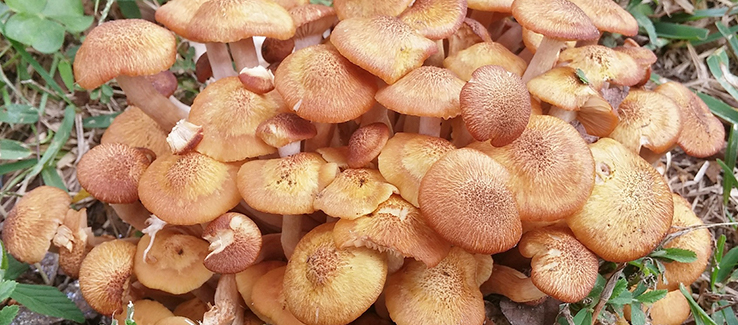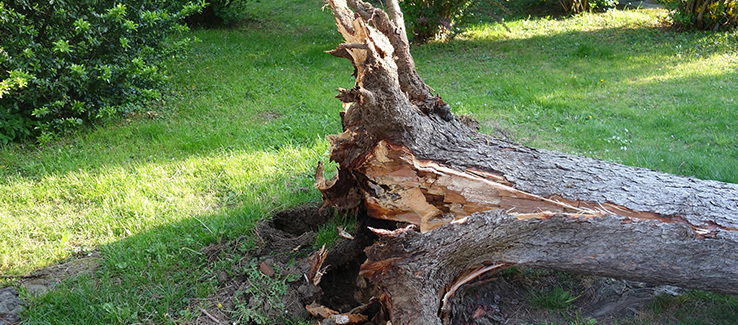
Prevent your trees and shrubs from dying and spreading root rot throughout your landscape. Knowing how to isolate and safely manage Armillaria root rot will help you keep your yard’s plant life thriving.
fasttreeremovalatlanta.com gathered information on what Armillaria root rot is, symptoms that help you identify it, how it survives and spreads, and what you can do to treat and prevent it.
What Is Armillaria Root Rot?
Armillaria root rot or mushroom root rot is a genus of fungi, Armillaria spp., that naturally decay tree stumps, dead wood, and roots. But Armillaria can also successfully attack living trees. While growing on dead wood, Armillaria produces rhizomorphs (root-like structures) that can grow 50 to 70 feet away from the original infection site. Larger infection sites support more significant, more extensive rhizomorph growth. Where rhizomorphs contact a potential host’s root system, they can infect those roots, causing growth problems and eventually girdling the tree.
Large trees may be able to compartmentalize the fungus in infected roots and survive for years. However, the host will grow progressively weaker as roots are killed, eventually becoming susceptible to windthrow. Smaller trees and plant life can be debilitated and killed more quickly.
Note: This fungus is found worldwide but prefers cool soils and climates.
Common Armillaria Root Rot – Hosts (Trees, Shrubs, Plants)
Armillaria infects a wide range of trees from oaks and hickories, to many hardwoods and conifers, like:
- Douglas-fir
- Lodgepole pines
- Ponderosa pines
- Spruce
- Grand fir pines
- Cedar
- Fruit trees
- Vines
- Shrubs
- Shade trees
Note: The only two genera of trees known to have developed a resistance to Armillaria root rot are larch and birch.
Armillaria Root Rot – Signs and Symptoms
While the majority of Armillaria root rot damage occurs below ground, the following visible signs indicate an Armillaria root rot infection:
- The tree may produce stress crops (abnormally large production of fruits, cones, or seeds)
- Foliage emerges small and/or chlorotic (yellowing) on deciduous trees
- Needles turn brown on infected evergreens
- Dieback in upper portions of the crown
- Large clusters of light-colored mushrooms growing at the base of the tree or on the root flare
- Thick, black fungal strands may grow on infected trees and in surrounding soil (like a net)
- Flat, white fungal growth appears in sheets between the bark and the wood at the base of infected trees and shrubs
- Trees will have decayed roots and a lower trunk (leaving the tree susceptible to windthrow or windsnap)
- The tree or plant will eventually die
Note: The base of infected pine and evergreen species (just below the soil surface) may be found encrusted in sap/resin.

How It Spreads and Thrives
Armillaria-causing fungi can survive for many years in wood debris, including stumps or root systems. New infections occur when healthy roots grow close to diseased roots. Rhizomorphs (black shoestring-like strands of fungal growth) can spread dozens of feet from an infected tree or stump to infect healthy roots.
Once the fungus colonizes the roots and the base of the trunk, the wood begins to decay. A healthy, robust tree can often slow the growth of the fungus. Still, stressed trees are usually damaged and debilitated quickly.
Trees die of Armillaria root rot when:
Girdling – roots can no longer move water and nutrients through the tree’s cambium
Windthrow – roots can no longer secure the tree to the ground in even the slightest breeze
Windsnap – the tree trunk is weakened and snaps in the wind

Note: Tyloses may also result in girdling. Occurring naturally, tyloses are formed in a tree or plant’s vascular system. They are are meant to plug or clog the vascular tissue in an attempt to prevent a disease’s advancement or from causing further damage to the tree.
Armillaria Root Rot Treatment
The first and most effective line of defense for your trees, shrubs, and plants is their health. The more optimal their conditions are for healthy growth, the better their chances are of remaining disease-free. Accomplish this by:
- Mulching the soil around the tree’s base out to the edge of the drip line
- Increase the tree’s watering schedule during drought (without leaving your plants and trees in standing water or poorly drained soil)
- Protect trees and shrubs from mechanical wounds (lawnmowers, weed whackers, and other equipment)
- Prevent pedestrian and vehicle traffic from the tree’s root plate to avoid soil compaction
- Remove unstable trees
- Remove infected stumps and as many roots as possible
Tip: Have your trees assessed annually by a certified arborist to determine if they are infected with Armillaria fungi and determine their structural stability.
Note: The more troubling aspect of Armillaria root rot is that, as of the publishing of this article, there is no definitive treatment or cure for the disease.
Watch this video about Armillaria fungi.
For further reading on this and other tree diseases, visit fasttreeremovalatlanta.com/9-oak-tree-diseases-identification-and-treatment
Handling Armillaria Root Rot
In this article, you discovered Armillaria root rot information, how to identify an active infection, how the pathogen survives and spreads, and what you can do to manage it and prevent it.
Keeping your landscape free of infected trees, shrubs, and plants will help you slow the progression of this prolific, robust fungal pathogen.
Allowing diseased/infected trees and plant life to persist on your property will accelerate the spread of Armillaria, exacerbating the sometimes invisible damage occurring beneath the soil and bark.
Sources:
gardeningsolutions.ifas.ufl.edu/care/pests-and-diseases/diseases/armillaria-root-rot.html
missouribotanicalgarden.org/gardens-gardening/your-garden/help-for-the-home-gardener/advice-tips-resources/pests-and-problems/diseases/rot/armillaria-root-rot.aspx
plantpath.cornell.edu/Trees/Armillaria.html
fs.usda.gov/Internet/FSE_DOCUMENTS/stelprdb5187208.pdf
(404) 220-9965
(404) 220-9963
To view the orignal version of this post, visit: https://www.fasttreeremovalatlanta.com/armillaria-root-rot-identification-treatment

No comments:
Post a Comment